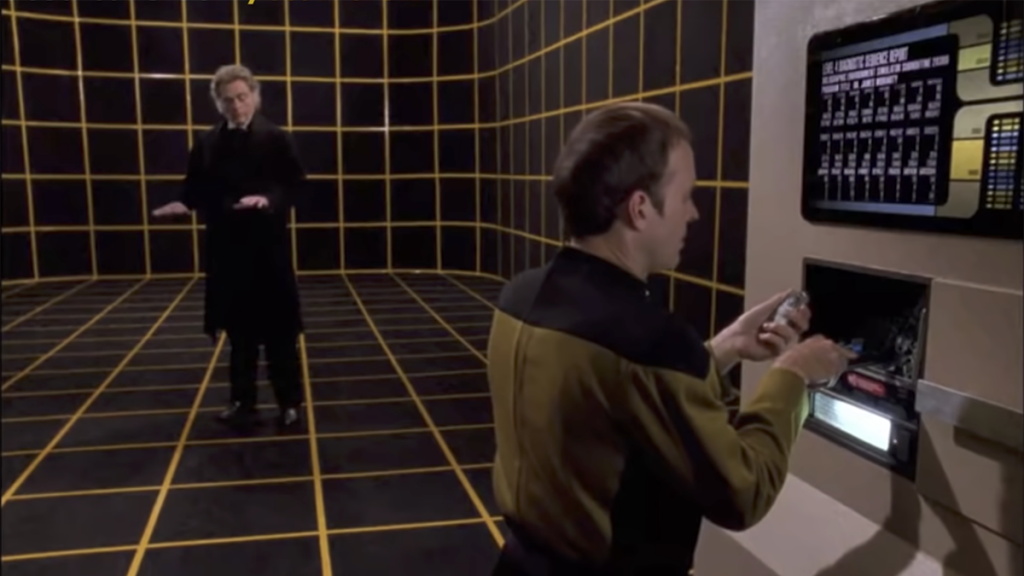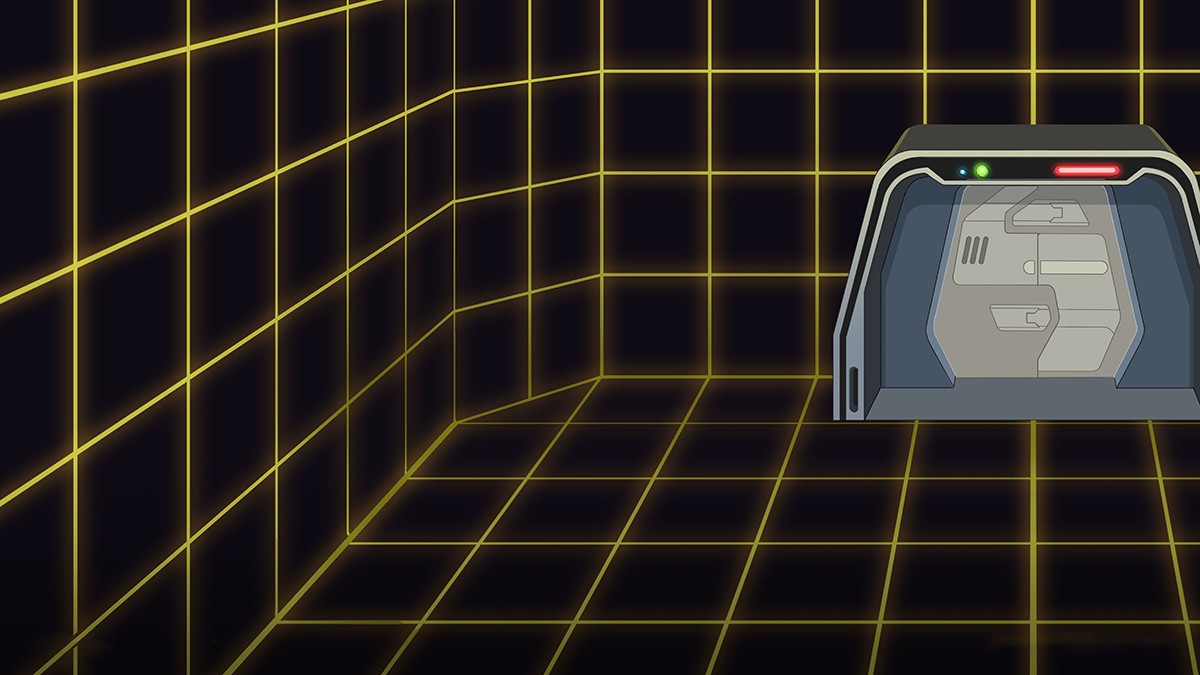Core Data:
- Vision: The Holodeck
- Type: Popular culture – TV/Film
- As Seen In: Star Trek: The Next Generation, Star Trek: Deep Space Nine, Star Trek: Voyager, Star Trek: Picard, Star Trek: Discovery
- Envisioned: 1987
- Visionaries: DC Fontana, Gene Roddenberry
- Target Date: 2364
Overview:
It’s all very well exploring the galaxy in a top-of-the-range starship. But even when you’re making occasional trips outside to explore some strange new world, those beige interiors are going to get a little monotonous.
The creators of Star Trek: The Next Generation had a solution, however – they fitted the USS Enterprise-D with numerous holodecks, all of them featuring the technology to create totally immersive simulations of anything the user could imagine.
An early incarnation, the ‘Recreation Room’, appeared in Star Trek: The Animated Series in the 1970s. The holodeck itself debuted in Next Generation pilot episode ‘Encounter At Farpoint’, and went on to become a regular fixture in both the long-running show and its spin-offs, Deep Space Nine and Voyager.
Over the years, the various holodecks have hosted Jean-Luc Picard playing a hard-boiled noir detective, a tense baseball match against a crew of Vulcans, and Data taking on Isaac Newton, Albert Einstein and Stephen Hawking in a game of poker. Holodeck episodes have traditionally been an excuse for Starfleet crews to spend some time away from the bridge, but they’ve also revealed that the technology – though undeniably sophisticated – has an alarming capacity to go dangerously wrong…

Key Tenets:
- Hardware: The holodeck is a large room capable of creating lifelike simulations of people, animals, objects and environments.
- Based around the principle that energy and matter are interchangeable (as in Albert Einstein’s famous E=mc2 equation), the holodeck works on a similar principle to the replicators that are used to fabricate food and materials in the 24th century. In other words, by the clever manipulation of light, forcefields and energy, the holodeck creates totally immersive spaces indistinguishable from real life.
- Although the ‘holograms’ are created from light, they have all the characteristics of physical objects.
- Entry to the holodeck is via an ‘arch’, which also features control panels to manage the simulation. The door is invisible when not in use.
- When not in use, the holodeck resembles a black box lined with a yellow grid.
- Experience: The primary function of the holodeck is recreation – crew members can go anywhere or do anything. Whether they’d like to meet an iconic figure from history, play the lead character in their favourite novel, or simply relax by the beach, the only limit is their imagination.
- The holodeck can also be used for practical purposes, such as training exercises and mission simulations.
- Built-in safety protocols mean that high-risk activities can be performed at minimal risk – in theory.
- Unfortunately, holodeck technology has a habit of going wrong on an alarmingly frequent basis. Notable examples include the accidental deactivation of safety settings (often with fatal results), and a simulation of Sherlock Holmes’ nemesis, Professor Moriarty, gaining sentience and trying to take over the USS Enterprise.
- Simulations are unable (at least initially) to leave the holodeck, though the USS Voyager’s Emergency Medical Hologram (EMH) – based on similar technology – later gains his own portable emitter.
- Several decades later, in Star Trek: Picard, entire ships can be fitted with holographic capabilities – to the point that La Sirena has a predominantly holographic crew. Bedrooms can be given a holographic makeover to look more like home.
- Travelling even further into the future, the 32nd century of Star Trek: Discovery features holograms that can completely alter a user’s appearance.
- Economics: According to Jean-Luc Picard, “The acquisition of wealth is no longer the driving force in our lives.” This means that the United Federation of Planets of the 24th century is a truly cashless society, and holodeck activities can generally be undertaken for free.
- There are exceptions, however. For Deep Space Nine’s Ferengi bar owner Quark, the acquisition of wealth is very much the driving force in his life, so he charges patrons for the use of his holosuites.
- IP: In theory you could transfer any IP you wanted to a holodeck setting, though Star Trek tends to play it safe by creating its own ‘brands’, such as 1940s detective Dixon Hill, or Flash Gordon-style adventure serial Captain Proton.
- Company: The hologram technology is owned by Starfleet, a subsidiary of the United Federation of Planets.
State of Play (October 2021)
- Hardware: Three-dimensional holographic images have existed since the 1960s (made possible by the invention of the laser), but they’re essentially just photographs with depth.
- The main obstacle standing in the way of a fully functioning holodeck is the laws of physics – as far as we know, it’s impossible to use ‘hard’ light to project solid objects.
- While walking into a room filled with fully interactive, solid holograms may be decades away (perhaps even impossible), existing technologies could be combined to create something approximating to the holodeck experience. Virtual reality headsets allow users to explore three-dimensional worlds, while haptic gloves can imitate the sensation of touch. Also, as AI and motion sensing technologies become more sophisticated, programs will be better equipped to respond to participants’ actions.
- TV, movies and games are already using immersive CG backgrounds to create the illusion of travelling to another world. Most famously, Star Wars spin-off The Mandalorian makes extensive use of a giant wraparound screen to transport the cast to believable alien locations.
- Experience: All of these holodeck approximations are extremely limited compared to what we see in Star Trek – they’re nowhere near as immersive or photo-real, and require the user to wear intrusive hardware.
- Economics: Einstein’s famous E=mc2 equation tells us that creating 1 kilogram of mass requires approximately 90,000,000,000,000,000 joules of energy – seeing as it would take a nuclear power station several years to generate that much electricity, creating a holodeck simulation is likely to be prohibitively expensive. That said, if anyone could create an affordable holodeck, its applications in entertainment and business would be so far-reaching that they’d be likely to make a fortune.
- Company: Creating a fully functioning holodeck would require so many different technologies that its development would either require significant collaboration or one company buying up others for their expertise. That, or the creation of a utopian interstellar organisation like the United Federation of Planets.

Reality check: Some way to go
Like warp drive and teleportation, Star Trek’s holodecks are as much about narrative convenience as reflecting the real-world. While Trek is always brilliant at creating a quasi-scientific explanation for its super-advanced tech, a sizeable suspension of disbelief is generally required – and that’s particularly true of a room that can simulate anything you care to think of.
That said, there’s plenty of technology in the real world that could combine to provide a holodeck-like virtual experience. It just lacks the user-friendly elegance of what we see in Star Trek.
Further reference:
A self-confessed full-time geek, freelance journalist Richard has spent most of his career writing about sci-fi and fantasy – including more than a decade on staff for SFX magazine. He's particularly keen on franchises with "Star" in the title.






































